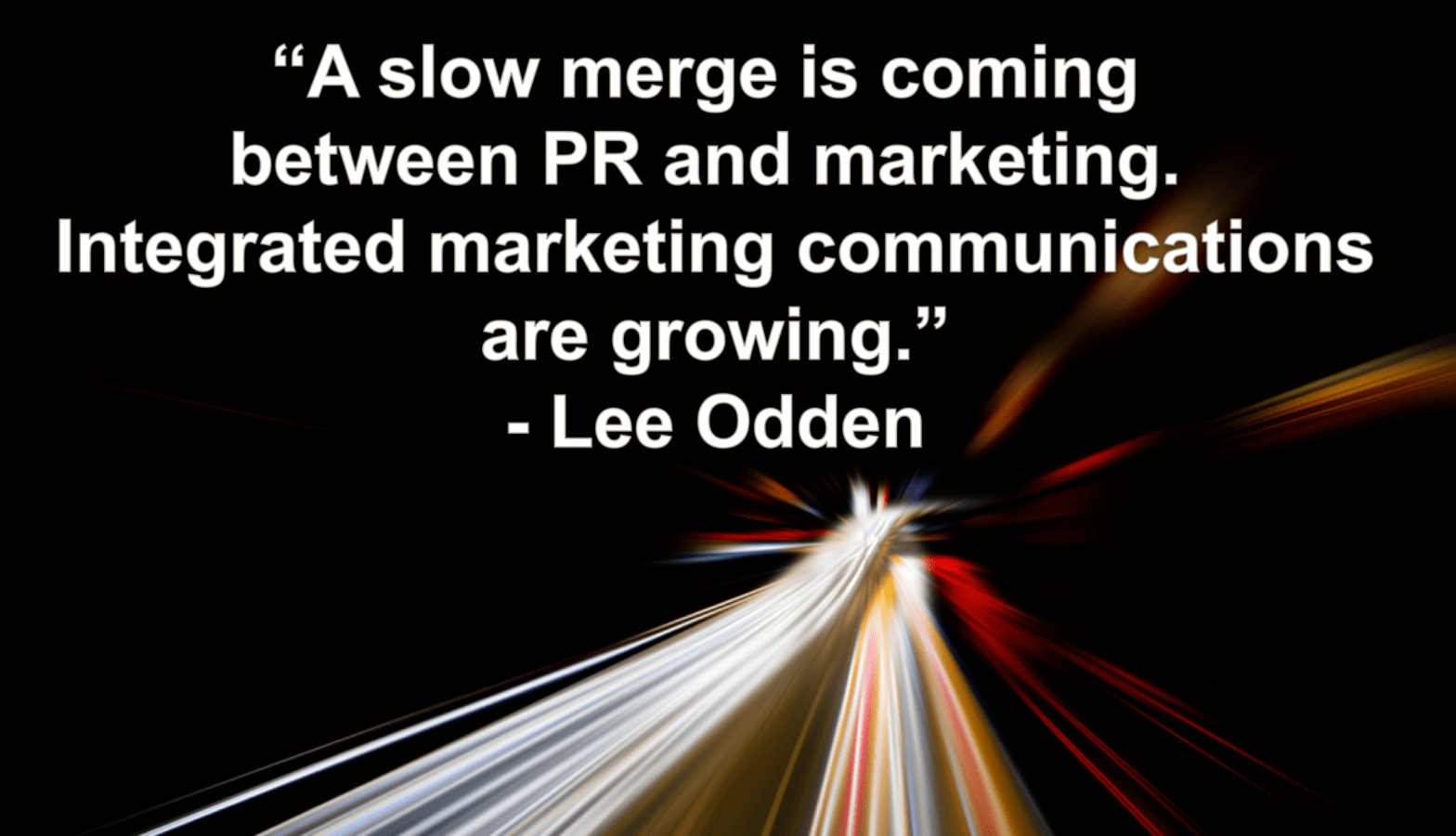
PR + marketing = the future of content marketing
What does the future of content marketing hold?
How will the practice of content marketing advance and evolve in the years ahead?
Content marketing is the vanguard of marketing. The more that consumers skip commercials and perform online research before they buy, the more content marketing will grow. It’s permission marketing.
“Permission marketing is the privilege (not the right) of delivering anticipated, personal and relevant messages to people who actually want to get them,” Seth Godin writes.
“It recognizes the new power of the best consumers to ignore marketing. It realizes that treating people with respect is the best way to earn their attention.”
What’s in the future of content marketing? Content is rising, as the Content Marketing Institute 2017 research shows:
- Almost 9 out of 10 marketers are using content marketing.
- More than one-fourth of marketing budgets are devoted to content marketing.
- More than 7 out of 10 marketers plan to create more content in 2017.
- For 2 out of 5 marketers, content budgets will grow in 2017.
As content marketing evolves, it will tap into related communications disciplines. As Lee Odden observes, “A slow merge is coming between PR and marketing. Integrated marketing communications are growing.”
To advance content marketing to the next level, marketing and PR must work closely together. Leaders need to do 3 things to succeed in getting the disciplines to work in harmony:
- Blend complementary skill sets.
- Co-create shared strategic plans and processes.
- Work together in a new and different way.
1. Blend complementary skill sets
Marketers and communicators are neighboring functions that bring a wide range of skills to the table. But only a handful of people have experience in both functions.
As you examine the skills of marketers and communicators, you find lots of overlap. Which skills do marketers bring to the content marketing table? Here’s a look:
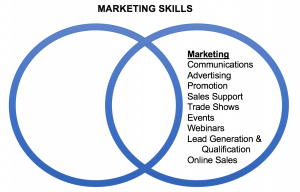
Marketers work across a wide array of communications vehicles – digital, print, and live. They often have access to more resources, since marketing budgets tend to be bigger than PR budgets. Marketers are used to:
- Approaching communications from a product-centric rather than customer-centric view
- Creating communications that sound like a sales pitch
- Having absolute control of content, timing, and placement.
The problem: those habits won’t necessarily serve you well as the future of content marketing unfolds.
That’s why, in the eyes of marketers, certain aspects of content marketing feel a little alien. Content calls on marketers to:
- Create content that educates customers more than it sells products.
- Keep information and a sales pitch separate to avoid losing readers’ trust.
- Court influencers to help spread content, trading off some control of the content, message, and timing.
Marketers are quickly learning and adapting to deliver what customers expect from content marketing.
What do PR people bring to the content marketing table? Here’s a look:
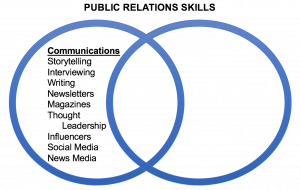
PR and communications people bring editorial skills that are crucial to content generation. They know how to interview, generate story ideas, tell stories, write, publish editorial content, and cultivate relationships with third parties.
Perhaps they’ve even worked as journalists and developed editorial instincts.
PR people are accustomed to:
- Serving as stakeholder advocates
- Not having control of the messenger, placement or timing
- Using the soft power of persuasion rather than the hard sell
- Defending the brand when it’s under attack.
But PR people are not used to:
- Driving customers into the lead funnel
- Qualifying leads
- Working with sales
- Measuring results as executives do – in terms of sales, customers, and revenue.
PR people may feel leery about shouldering such responsibilities, which usually belong to marketing or sales. Some bluntly say, “Sales is not my job.”
But in business (and even a nonprofit), sales is part of everyone’s job. All organizations need sales, customers, and revenue.
The future of content marketing will demand direct involvement in sales for PR people too.
How CEOs look at PR and marketing
When they don’t lean into business needs, PR people lose opportunities to contribute to the business and get credit for what they do.
Ask yourself: Do your executives see PR people as essential to winning sales, customers, and revenue?
For content marketing to advance, we must shape leaders’ perception, so they connect the dots from PR, marketing, and content to customers, sales, and revenue.
One CEO told me, “When anyone walks into my office, I see a penny on their forehead. Sometimes I see a penny of expense, sometimes I see a penny of profit.”
Successful content marketers are the ones who come into the CEO’s office with a penny of profit on their foreheads. They help the CEO connect the dots from content marketing to sales, customers, and revenue.
Leaders who take advantage of marketers’ and communicators’ overlapping skills can maximize the results they gain from content marketing. That’s what the future of content marketing holds.
Many PR and marketing skills overlap. People in both functions handle research, messaging, blogs and production. When each function learns new skills from its neighbor, both can unlock content marketing innovation.
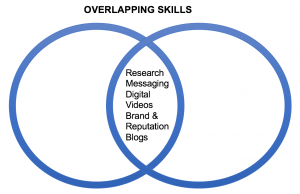
We in PR and marketing need to learn each other’s languages. For example, what a marketer calls brand, a PR person calls reputation.
In fact, brand and reputation are just two sides of the same coin. Both are assets that must be built slowly but can be shattered in a flash.
Both dwell in the hearts and minds of customers, employees, and other stakeholders, rather than in the control of companies.
Companies that cross-train marketing and PR people create a team that’s ready for the future of content marketing. Here’s what that looks like:
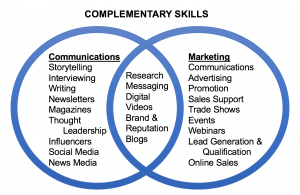
Years ago, I was lucky enough to learn integrated marketing communications from Clarke Caywood and his book The Handbook of Strategic Public Relations and Integrated Marketing Communications.
Using his idea, we put integrated marketing communications into practice at Tellabs back in 2001. To start, we united the marketing and PR functions under one roof.
As vice president of the unified team, I found tremendous upsides. Instead of having a separate Army and a separate Navy, we became more like the Marines, ready to act quickly in any scenario.
While one organization inherently acts faster than two, organization charts alone don’t equate to success. To succeed as a unified force, we needed to do much more.
2. Co-create shared strategic plans and processes
It can be a struggle to get separate marketing and PR functions onto the same page. Start by co-creating unified plans and processes that marketers and communicators share.
To fully integrate the functions, leaders must take both far beyond their comfort zones.

To succeed in practicing integrated content marketing, our whole team had to pull together to co-create 4 key elements:
- A written mission statement to define what success looks like
- A written strategy, a contract on what’s to be delivered
- Unified messages, so everyone could sing from the same songbook
- Metrics and analytics to measure performance and enable improvements.
Now let’s apply these elements to the future of content marketing.
Content Marketing Mission Statement
Agreeing on your high-level mission – who you’re addressing, what you will deliver to them and how it will help them succeed – is crucial.
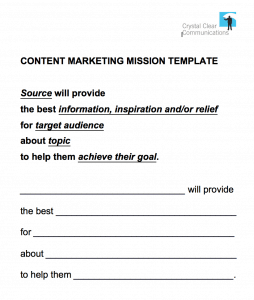
To help you create a written content marketing mission statement, here’s:
- A blog on content marketing mission statements
- A free template for your content marketing mission statement.
Content Marketing Strategy
To write a content marketing strategy that gets used every day, boil it down to one page. With your whole strategy on one page, you can focus the attention of your executives, clients, and practitioners.
To help you write your strategy here’s:
- A Content Marketing Institute blog on how to create a 1-page content marketing strategy
- A free template for your 1-page content marketing strategy.
Message Map
To get your whole team, executives and internal clients on the same page with an integrated marketing and communications message, use a tool called a Message Map.
To learn more about Message Maps, start with these blogs:
- What is a Message Map?
- How to Keep Your Content Marketing on Message – Always.
- The most-read blogs on Message Maps.
All-In Analytics Review

At least once a quarter, convene your team to review your marketing and communications metrics together. Once a month is even better to keep measurement top of mind.
To perform an all-in analytics review, you need to pull together a tremendous amount of data that comes from disparate systems. Assign a deputy to build an analytics presentation that pulls together these results:
- Email (opens, click-throughs, subscriptions)
- Website (analytics, heat map)
- Social media (posts, interactions, shares, clicks)
- Videos (watched, shared, subscriptions)
- White papers (downloads, registrations)
- App usage
- Public relations results (tone, message delivery, audience reached)
- Ad clicks
- Soft and hard conversions
- Inquiries
- Marketing-qualified and sales-qualified leads
- Sales
- Customers
- Revenue
- Brand value
- Other critical measures.
Track trends over time on fever charts. Once you’ve captured 24 months of data, you’ll be able to compare results year over year, and separate seasonality from other drivers.
Ask individuals to develop a hypothesis about what’s driving trends. Then share a set of competing hypotheses with the whole team, so you can refine them before testing.
Conduct experiments to find out which hypothesis holds up. Test each hypothesis with A/B tests and other means to find out which is valid empirically.
The results of your experiments and tests will reveal new ways forward and help you evolve your content marketing to the next level.
3. Work together in a new and different way

Over three decades in communications and marketing, I’ve seen the functions interact in two ways – either as a team that works together or as rivals that work against each other.
Inside corporations, unfortunately, separate departments often act as competing fiefdoms. They speak different languages. They compete for budget, headcount, recognition, even survival.
Such teams of rivals usually deliver less-than-maximum results for a company. They won’t fit into the future of content marketing.
During my time as vice president of communications at RR Donnelley, the marketing team and communications team tried to work together. But we failed. Why?
- We were not a unified organization but two separate groups, reporting to different executives who had different objectives.
- We did not co-create shared plans and processes.
- Ultimately, the decisions we made placed the needs of each department ahead of the needs of the company and our customers.

One way to check how your marketing and communications teams are working is to ask people in each department the question:
Who do you work for?”
How do you answer that question?
Do you answer with your boss’ name? Your department’s name? Your company’s name? Or your customers?
If you answer with your boss’ or department’s name, it probably will take a longer journey to reach the future of content marketing.
If you answer with your company’s name or with your customers, you have the right reflexes to reach the future sooner.
Yes, to many people that choice feels unnatural. In the end, taking an unselfish approach serves companies, customers and you better. In the long run it enables you to achieve even bigger successes.
What’s the best way to advance the future of content marketing?
As consumers skip commercials and perform research online before they buy, content marketing will continue to grow – and evolve. It’s here to stay.
Integrated marketing communications also are on the rise.
But the obstacles to integrating marketing and PR are perpetual. The companies that succeed:
- Blend complementary skill sets.
- Co-create shared strategic plans and processes.
- Work together in a new and different way.
I believe that Lee Odden is spot on: a slow merge between marketing and PR is ahead, which will make marketing communications much more integrated. It points to the future of content marketing.
Integrating marketing and PR is a powerful way to unlock success and evolve content marketing into the future.
Learn more about the future of content marketing

To learn more from Lee Odden, hear him speak in Chicago at the 2017 Masters of BtoB Marketing, presented by ANA’s Business Marketing Association, May 31-June 2.
To learn more about content marketing, subscribe to my blog. Join my ANA workshop Fast-Forward Your Content Marketing, in New York City on February 23 and Burbank May 3.
Related Posts
How to squeeze everything into your tight marketing budget
How to squeeze everything into your tight marketing budget. Many companies are asking marketers to get the job done with fewer resources in the...
Are you afraid of naysayers when presenting?
Recently I’ve had several clients ask me how to handle naysayers when presenting. Most of us have heard that presenting and public speaking are...
Teach your content to sing
I’ve played guitar for 50 years, but I started to write songs only a few years ago. Here are ideas borrowed from songwriting that...
77 Ideas to Simplify Content from Einstein, da Vinci, Shakespeare, Chopin, Thoreau and More
Here are 77 ideas to help you simplify content. Do you think experts are working overtime to make content marketing seem more and more...





